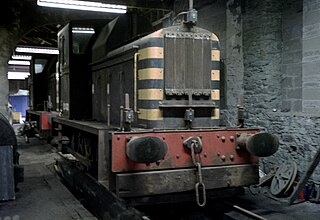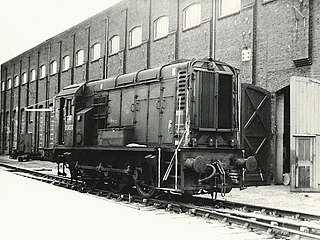Related Research Articles

The British Rail Class 01 diesel locomotive is a short wheelbase 0-4-0 diesel-mechanical design intended for use in areas with tight curves and limited clearance.

The British Rail Class 04 is a 0-6-0 diesel-mechanical shunting locomotive class, built between 1952 and 1962 and was the basis for the later Class 03 built in the British Railways workshops.

The British Rail Class 05 is a class of 0-6-0 diesel-mechanical shunters built by Hunslet Engine Company from 1955 to 1961. They were used on the Eastern and Scottish Regions of British Railways. The first two batches were delivered as 11136-11143 and 11161-11176. Subsequent locomotives were delivered, new, as D2574-D2618.

The British Rail Class 06 is a class of 0-4-0 diesel-mechanical shunters built by Andrew Barclay Sons and Company from 1958 to 1960 for use on the Scottish Region of British Railways. They were originally numbered D2410–D2444 and later given the TOPS numbers 06001–06010.

The British Rail Class 07 diesel locomotive is an off-centre cab 0-6-0 diesel-electric shunter type built by Ruston & Hornsby in 1962 for the Southern Region of British Railways. The 14 members of the class were primarily used at Southampton Docks and later also at Eastleigh Works.

The British Rail Class 08 is a class of diesel-electric shunting locomotives built by British Railways (BR). As the standard BR general-purpose diesel shunter, the class became a familiar sight at major stations and freight yards. Since their introduction in 1952, however, the nature of rail traffic in Britain has changed considerably. Freight trains are now mostly fixed rakes of wagons, and passenger trains are mostly multiple units or have Driving Van Trailers, neither requiring the attention of a shunting locomotive. Consequently, a large proportion of the class has been withdrawn from mainline use and stored, scrapped, exported or sold to industrial or heritage railways.

The British Rail Class 10 diesel locomotives are a variant of the standard Class 08 diesel-electric shunter with a Lister Blackstone diesel engine and General Electric Company plc (GEC) traction motors. The locomotives were built at the BR Works in Darlington and Doncaster over the period 1955–1962, and were withdrawn between February 1967 and June 1972.

The British Rail Class 11 was applied to a batch of diesel shunting locomotives built from April 1945 to December 1952, based on a similar earlier batch built by the London, Midland and Scottish Railway (LMS) between 1934 and 1936.
British Rail reserved the TOPS Class 97 designation for departmental locomotives, which were used for special or engineering duties. They were therefore of several different classes, lumped together for numbering purposes. Some locomotives were converted from redundant engines, whilst others were purpose built. In 2008, Network Rail once again used Class 97 for signalling test locomotives.
A number of different numbering and classification schemes were used for locomotives and multiple units operated by British Railways (BR), and this page explains the principal systems. This section also covers the post-privatisation period, as the broad numbering and classification arrangements have not altered since the break-up of BR.
Before the TOPS Class 97 was issued to self-propelled locomotives in departmental use, British Rail had such locomotives numbered in a variety of series, together with locomotives that were no longer self-propelled. See Also:

The British Railways Class D3/7 is a class of 0-6-0 diesel electric shunting locomotives built as LMS Nos. 7080–7119. The class were built from May 1939 through to July 1942 by the London, Midland and Scottish Railway at their Derby Works using a diesel electric transmission supplied by English Electric.
The Great Western Railway purchased two diesel shunters, and ordered a further seven immediately prior to Nationalisation, which were delivered to British Rail in 1948–49. The two shunters used by the GWR were numbered 1 and 2, while a series commencing at 501 was planned for the new locomotives ordered in the 1940s. British Rail numbered 2 and the new locomotives in a series commencing at 15100.
A number of different numbering and classification schemes were used for the locomotives owned by the London, Midland and Scottish Railway (LMS) and its constituent companies; this page explains the principal systems that were used.

The Midland Railway 1377 Class was a class of 185 0-6-0T tank locomotives. They were introduced in 1878 by Samuel W. Johnson, and were almost identical to the 1102 class of 1874; the latter having fully enclosed cabs, while the 1377 class were built without a rear to the cab and only a short cab roof, hence their nickname "half-cabs". They were given the power classification 1F.

The F Class are a class of diesel locomotive shunters built by Dick Kerr Works for the Victorian Railways between 1951 and 1953. They are similar to the British Rail Class 11 and NS Class 600 shunting locomotives also built by English Electric during this period, but modified for use on the VR's 5 ft 3 in (1,600 mm) broad gauge.

LMS diesel shunter 7050 is an experimental 0-4-0 diesel-mechanical shunting locomotive, introduced by the London Midland and Scottish Railway (LMS) in 1934 and which remained in service with that railway for six years. It was later acquired for military use and is now preserved at the National Railway Museum.

The British Rail Class D3/6 were diesel shunters designed in 1934/5 by English Electric for the London, Midland and Scottish Railway. (LMS)
The Drewry Car Co was a railway locomotive and railcar manufacturer and sales organisation from 1906 to 1984. At the start and the end of its life it built its own products, for the rest of the time it sold vehicles manufactured by sub-contractors. It was separate from the lorry-builder, Shelvoke & Drewry, but it is believed that James Sidney Drewry was involved with both companies.
LMS diesel shunter 7058 was based on an earlier Armstrong Whitworth prototype of 1932, which had been tested by the London, Midland and Scottish Railway. It was initially numbered 7408 and then re-numbered 7058.
References
- ↑ Strickland, D.C. (1982). Locomotive directory: every single one there has ever been. Camberley: Diesel and Electric Group. p. 21. ISBN 0-906375-10-X.
- ↑ Oakley, Michael (1979). Diesel shunting locos: a pictorial history. Truro: Bradford Barton. p. 3. ISBN 0-85153-361-2.
- ↑ Strickland 1982 , p. 21
- Rowledge, J.W.P. (1975). Engines of the LMS built 1923–51. Oxford: Oxford Publishing Company. ISBN 0-902888-59-5.